Change font size -A A +A ++A
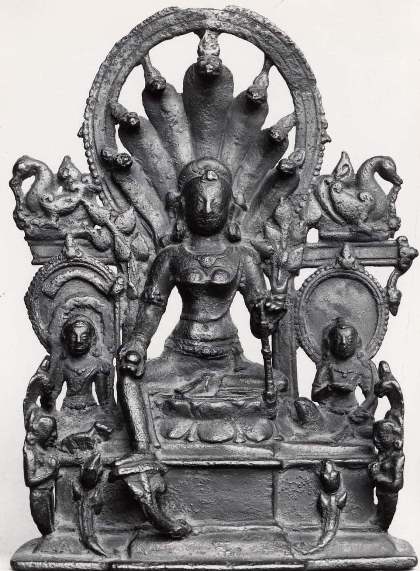
Ancient metal idol of Manasa deity.
Our Bureau/
On set of Monsoon, ie, soon the month of Shravan arrives, in the eastern parts of Bihar, formerly known as Anga Pradesh, preparations for Manasa or Bisahari puja starts at war foots.
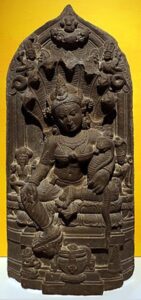
Manasa with her husband Jaratkaru & son Astika flanked by Nagas, 11th century Pala period statue from Bengal.
Manasa is a Hindu goddess of snakes, worshipped mainly in Bengal, Jharkhand, Lower Assam and other parts of northeastern India and in Uttarakhand apart from Anga Pradesh mainly for the prevention and cure of snakebite and also for fertility and prosperity.
According to mythological textures Manasa is the sister of Shesha and Vasuki, king of Nāgas (serpents) and wife of sage Jaratkaru. She is also the mother of the sage Astika. She is also known as Bisahari (the destroyer of poison), Nityā (eternal) and Padmavati.
Origin of Manasha
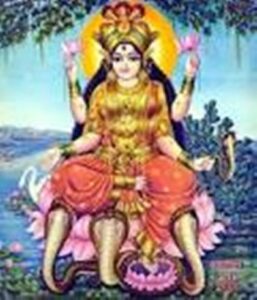
Ancient portrait of Manasa from Bengal. Manasamangal Kāvya, a composition in Bengali language is the oldest of the Mangal-Kāvya and narrates how the snake-goddess Manasa established her worship in Bengal (read Greater Bengal) by converting a worshipper of Shiva to her own worship. Manasa was a non-Aryan deity and her worship was an ancient one in Bengal. It is believed she came to Bengal with the Dravidians who worshipped her in the hope that she would protect them against snakes. Manasa is also known as Bisahari, Janguli and Padmavati.Some eminent historians suggest another influence on Manasa being the Mahayana Buddhist goddess of poison-cure Janguli. Janguli shares his swan vehicle and her poison-destroyer epithet with Manasa. Manasa is also known as Jaguli.
The earliest poet of this genre of medieval Bengali literature was probably Kana Haridatta (c. 13th century), but his work is no longer existent. His name is found in both the works of Bijay Gupta and Purushottam. Other poets who composed versions of Manasamangal after him were Purushottam, Narayan Deb (c 15th century), Bijay Gupta and Bipradas Pipilai. Bijay Gupta’s Manasamangal (or Padmapuran) (1484-5) is perhaps the most popular of these versions because of its rich literary qualities. Bipradas Pipilai’s Manasabijay (1495-6) was also composed during the same period. Narayan Deb’s work is also known as Padmapuran.
Ketakadas Kshemananda (c.17th century), Jagajjiban Ghoshal (c.17th century) and Jibankrishna Maitra (c.18th century) were later poets of this genre.
Glimpses from ancient history
In the ancient time Anga Pradesh having its capital, Champa (near present Bhagalpur) was under the geographical territory of Greater Banga (Bengal).
If we want to know the history, we must go back a little bit. Human settlements in this part of the country could be traced back to 20,000 years. In the Stone Age and the Copper Age, it was probably in the western frontier region of Bengal, where the first human habitation began and later spread to other places. Remnants of Copper Age settlements date 4,300 years back.Archaeological evidence confirms that by the second millennium BC, rice cultivating communities inhabited the region. By the 11th century BC, the people of the area lived in systemically-aligned housing, used human cemeteries and manufactured copper ornaments and fine black and red pottery.
According to established beliefs this region reflected major similarities which were found in Harappa civilization. Many beliefs, after the decline of Harappa civilization, some survivors ( as it believed that due to the wide scale aggression by the Aryans the Harappa civilization was destroyed) managed to migrate towards south and among them some of them shifted towards the eastern part of the country.
Hence the ancient natives of the eastern parts of the country were the successor of Harappan civilization.
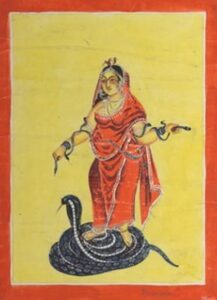
Kalighat painting of goddess Manasā standing on a snake with a few wrapped in her hand, Cleveland Museum of Art
Geographically Anga Pradesh had been much influenced by Banga (depicting inside the geographic boundaries of the ancient part of greater Bengal, the term ‘Greater Banga’ however in practice from middle-age , ie, after Muslim invention in this region). Their home-turf fell under the jurisdiction of Banga and Anga was located just beside the territory of Banga or whatever the name of the place might be in ancient times. There are many pieces of evidence to prove that both civilizations existed much before the beginning of the Vedic period as well. There are many references to these areas even in several texts of the Vedic era including Ramayana and Mahabharata. Therefore, it can be said that it was contemporary with the Harappan civilization.
The issue of ‘Aryan immigration’ has been a hot issue of debate for many decades. Aryans had migrated to India 4000 years ago or so after Harappan civilization started declining.
Being a part of ‘Greater Banga’, the inhabitants of this region probably migrated from northwestern part along with the Dravidian and Austro-Asiatic sub-family of the Austric family of languages.
However, those areas were completely free from Vedic or Brahmical influences at that time when the Aryan civilization had just started spreading in the western parts of India. The culture of worshipping deities of Mother Nature by the residents of this entire region had its influence on this part of the land as is evident from several instances. The ancient traditions had their epicenters at different prominent places like Chandrakatugar or the mound of king Pandu is said to be around 4000 years old.
It should be remembered that at that time this Greater Bango was known as Pundro. In Purana and different religious texts like Mahabharata, the name of Pundra mentioned several times.
When the Vedic Aryans settled in the land of five rivers (Punjab province) they didn’t have any relationship with this eastern part of the country even after a long time. There is no mention of this part in Vedic sources.
Hamilton first shed light on the civilization in 1808 and it was accurately identified by Alexander Cunningham. According to historian Willison Rajsahi, Dinajpur, Rangpur, Nadiya, Birbhum, Burdwan, 24 Parganas, parts of Medinipur, parts of Bihar’s Ramghar, Palaumo, and Chunar were inside the geographical territory of Pundro. Cunningham however added the Pabna district inside it. William Ferguson claimed that Rajmahal (ancient Kajangal) and Silliguri were inside the territory of it. Bankimchandra Chatterjee in his ‘Bibidho Prabhando’ claimed that Malda district was also part of Pundra while some modern historians claimed that Anga (modern Bhagalpur) was also inside Greater Banga.
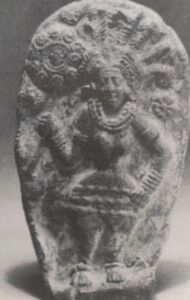
The current location of this terracotta mother statue from Tamal Dasgupta Chandraketugarh is unknown. Image collected from Twitter. Translation.
Panchanan Mitra in his book ‘Glimpses of Glorious Past of the Pod People’ had mentioned, “The Pundra was an old race. They knew agriculture and exploited the rich mines first in India. Punyan dynasty in the Decan and the great Padma of the Nanda dynasty of Magadha were the last glimmers of the dying race….”
Archaeological evidences – sculptures of Manasa
Manasa images made of stone, bronze and terracotta recovered from different places of the country have some common features. Most of the images bear two or four arms, the crown on the head designed with seven expanded snake hoods, Manasa was sitting in between husband Jaratkaru and brother King Vasuki with son Astika on the lap. On the right hand she is phal-anjalihasta, on the left she holds Astika or sometimes a snake. When she is four armed, she holds betel leaves on her upper hands and on the lower right she is phal-anjalihasta, some other types are also noticed. In an image of Varendra Reseach Museum, she is sitting in a yogic posture holding a rosary on the lower right, a snake on the upper right and a manuscript on the lower left and a Ghat (bowl) on the upper left hand.
The image of Manasa found earlier in Mangalkot in Bogra (Bangladesh) is regarded as the earliest one, has two arms. Most of the two-armed idols of Manasa hold the son Astika by one hand and a pot by the other. The heads of these idols are covered with crowns designed with expanded serpent hoods. Over 48 images of Manasa have so far been discovered from North Bengal. Some of them were built during the Gupta rule in the fifth or sixth century. Some archaeological sites in Bogra district are named after the characters mentioned in Manasamangal. These are Basar Ghar of Behula-Lakhindar (the bride chamber of Behula and Lakhindar), Netai Dhopanir Pat, Ojha Dhanwantorir Bhita, Chander Bari (the home of Chand), Chander Dhap, Godar Dhap etc. The names suggest that the Manasa cult was deep rooted and originated in North Bengal.
Similarly, during the excavation of Vikramshila Buddha Mahavihara, two metal made sculptures of Manasa were recovered. Like the places in North Bengal, Anga Pradesh however does not have any particular place named the characters mentioned in Manasamangal. But people talk about Champanagar in Bhagalpur and Ujani at Naugachia sub division in Bhagalpur in reference of Behula-Bisahari. Noted historian, N L Dey in his book ‘ Ancient Geography of India’ mentioned that the Behula-Bisahari episode was taken place at Champa (modern Champanagar in Bhagalpur).
Most of the metal and stone images of Manasa found so far are believed to be made during the pre-Muslim period. After the advent of Muslims in Bengal changes took place in the form of Manasa image making the mythological era coming to an end and heralding the new era of mangalkavya. So human characters like Chand Saodagar, Lakhindar, Behula, Shulka replaced the puranic characters of Jaratkaru, Vasuki, Astika Muni etc in the story of Manasa. Like Brahma and Saraswati, Manasa possessed the same vehicle, goose. Idols of Manasa found so far have different features. In many places three hands of the 4-armed images hold snakes and the rest one holds a boon. In some cases, all the hands of the deity hold snakes. A form of eight serpent hoods are known as Ashtanaga Manasa. The deity is also worshipped as ‘ghat’ in some places.
Sarpamatrika or Ancient Manasa of Gangaridai / Gangal civilization
Snake mother was a mother-divine early age of the land of Greater Bengal. The roundel attached to the skull (of course, protected by a bar, so it may not be part of the skull even though it is attached to the skull) i.e. the chakra on the right is a proto Rasmandal, a sculpture was recovered from the archaeological excavation from Chandraketugarh (see in picture).
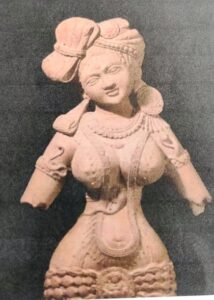
This Terracotta mother-nature immage found from the excavtion at Chandrakatughar. This Pic is collected from Twitter.
In such a Chakra (cycle), mother-divine ( Sarpa Matrika) was established, it played the role of an instrument in the tantric behavior of this subcontinent. Incidentally, since the time of the Harappan civilization, the Chakra has been a symbol of eternal nature.
It is clear from the said archaeological plaque that Pratna Rasamandal on the right, five serpents on the left. In those days when mother-divine used to come from the soil itself. Take a good look, you will surprise to find the unique facial expression of that mother-deity.
Many experts guess that Chand Sadagar carries the memory of Bengal’s flourishing international spice trend in the BC period, and the dramatic confrontation between Chand and Manasa testifies to Bengal’s identification with Greek mythology. Incidentally, the first mention of the Gangaridai civilization was found in the Greek mythology of the third century BC: Argonautica.
Very unfortunately this Sarpa Matrika will also disappear with the fall of Gangaridi civilization two thousand years after, until the rise of Pala era, and all the lost mothers of Gangaridi civilization will return as warrior mothers in new costumes.
How old is snake worship in the subcontinent?
Serpent worship in the Harappan civilization is sparsely

The broken face of Manasa . This Pic is taken from Pinterest.
The broken face of Manasa . This Pic is taken from Pinterest.
documented, but not as popular (a total of four or five seals have been found in the Harappan civilization that selate the ritual importance of snakes). Presumably, this Sarpamatrika became particularly popular in Eastern India as an Austroasiatic element at the root of the mother-worshipping Greater Banga. Dravidian influence was already present in Harappan civilization, and Naga (snake) worship in Harappan civilization is very weak, so the popularity of Naga cult in eastern India cannot be explained by that Dravidian influence.
A Buddhist treatise written in Pali language called Niddes in the BC era says that elephants, horses, cows, dogs, crows, Vasudeva, Baladeva, Punnabhadda, fire, Naga, Yaksha, Asura, Gandharva, Maharaj, Surya, Chandra, Indra, Brahma and Deva worship were prevalent in contemporary India. Therefore, it is proved that snake worship was prevalent in the BC era. Since the natives of Greater Banga are mother-worshippers, the serpent deity has become the serpent mother there. Looking at the Sarpa Matrika obtained from Chandraketugarh. I would like to call it Adimansa or Proto-Mansa. .
The relevancy of Manasa/Bisahari puja at Anga Pradesh
Manasa which is known as Bisahari in Anga Pradesh, has a very ancient history. Many suggested that the Bengali tale of Manasa reflects rivalry between Shaivism and Goddess-centric Shaktism. Some modern feminists have defined it as the symbol of women empowerment. But interestingly, today’s puja system and the theme of the whole puja, however, points in this direction as a whole.
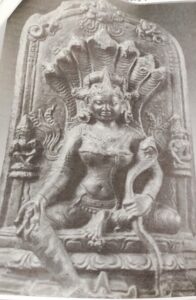
Ancient Manasa or Sarpomartrika. This pic is taken from site of a Franceh Auction house.
Anga Pradesh, which was once an important part of greater Bengal, today is a separate state of Bihar, but could not break free from that past. Parts of that past exist today, particularly in culture, religion and reform.
And so here is the predominance of Matrika worship like Manasa/Bisahari, exemplified today in some parts of that ancient culture of Anga.
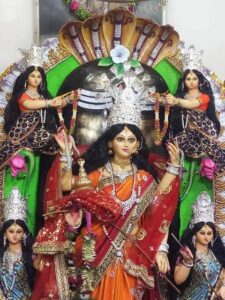
Modern Manasa or Bishari idol at Bhagalpur.
Pix By Khalid Chand.
But it is very surprising that the ancient practice of worshiping Mother Nature has been going on for thousands of years. Although Anga Pradesh is outside Bengal today, a lot has changed with the passage of time. So today Bishari Puja continues to be practiced in Anga Pradesh but its form has changed; the entire puja rituals concentrated on the folk-lore of Behula-Bisahari. Not only that it already developed Manjusha art, the pictorial depiction of Behula-Bisahari episode. Manjusha art just like Madhubani painting, it now has great market demands.
Not only Manasa/Bisahari residents of Anga Pradesh usually worship mother-deities. In comparison to other parts of Bihar one easily could observed prevalence of Manasa/Bisahari puja along with Durga Puja, Kali Puja are very high in this region.



Leave a Reply